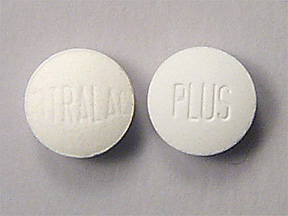Titralac Plus Interactions
There are 225 drugs known to interact with Titralac Plus (calcium carbonate / simethicone), along with 5 disease interactions, and 1 alcohol/food interaction. Of the total drug interactions, 13 are major, 159 are moderate, and 53 are minor.
- View all 225 medications that may interact with Titralac Plus
- View Titralac Plus alcohol/food interactions (1)
- View Titralac Plus disease interactions (5)
Most frequently checked interactions
View interaction reports for Titralac Plus (calcium carbonate / simethicone) and the medicines listed below.
- Accutane (isotretinoin)
- acetaminophen
- acetaminophen / butalbital / caffeine
- Adalat XL Plus (aspirin / nifedipine)
- Advil (ibuprofen)
- Alcohol (contained in alcoholic beverages) (ethanol)
- Allegra (fexofenadine)
- Allegra-D 24 Hour (fexofenadine / pseudoephedrine)
- allopurinol
- Ambien CR (zolpidem)
- amiodarone
- Aspir 81 (aspirin)
- aspirin
- Astepro (azelastine nasal)
- benzonatate
- Calcium 600 D (calcium / vitamin d)
- chloroquine
- citalopram
- Detrol LA (tolterodine)
- duloxetine
- epinephrine ophthalmic
- fluticasone
- ibuprofen
- Klonopin (clonazepam)
- Leader Naproxen Sodium (naproxen)
- loperamide
- loratadine
- Pepto-Bismol (bismuth subsalicylate)
- Phenergan (promethazine)
- Tylenol (acetaminophen)
Titralac Plus alcohol/food interactions
There is 1 alcohol/food interaction with Titralac Plus (calcium carbonate / simethicone).
Titralac Plus disease interactions
There are 5 disease interactions with Titralac Plus (calcium carbonate / simethicone) which include:
More about Titralac Plus (calcium carbonate / simethicone)
- Compare alternatives
- Reviews (3)
- Drug images
- Side effects
- Dosage information
- During pregnancy
- Drug class: antacids
Related treatment guides
Drug Interaction Classification
| Highly clinically significant. Avoid combinations; the risk of the interaction outweighs the benefit. | |
| Moderately clinically significant. Usually avoid combinations; use it only under special circumstances. | |
| Minimally clinically significant. Minimize risk; assess risk and consider an alternative drug, take steps to circumvent the interaction risk and/or institute a monitoring plan. | |
| No interaction information available. |
See also:
Further information
Always consult your healthcare provider to ensure the information displayed on this page applies to your personal circumstances.


